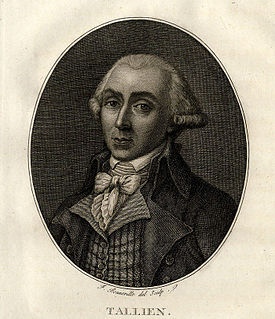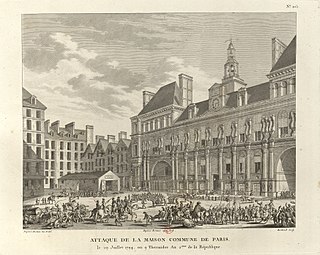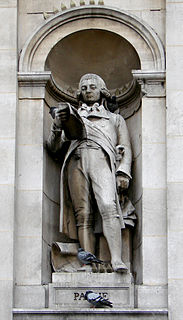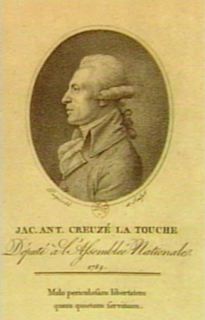Biography
The Baudin family had originated in Lorraine,but had been fixed since the seventeenth century in Sedan. He was the son of Anne-Alexandre Baudin,lieutenant general of the Bailiwick of Sedan,and Charlotte-Louise Lafeuille,who descended from a family of magistrates. His father destined him to the legal career;he studied in Paris under the tutelage of a disciple of Rollin and Coffin. After law school,he was received into the Bar,but the exile of the Parliament of Paris in 1771 led him to abandon this career. He agreed to become the tutor of the son of General Counsel Gilbert Voisins. Married in 1783 to Marie-Jeanne Elisabeth Terreaux (whose sister Antoinette later married Jean Henri Hassenfratz),he returned to Sedan,where he became director of the Post Office,an appointment facilitated by Voisins. [2]
Elected mayor of Sedan in 1790,and subsequently as deputy of the Ardennes to the Legislative Assembly on 2 September 1791 by 168 votes out of 299 voters,he sat among moderates but spoke little. [3] He was,according to historians,useful for his serious approach to social problems. He rarely went on missions,but worked hard on committees,accomplishing some of the real work of reform behind the scenes. On 5 September 1792,he was re-elected to the National Convention. At the trial of Louis XVI,he voted in favor of the appeal to the people and imprisonment of the king until a general peace was reached. Unlike some of the other men who supported this option,he was not a Signatory of the Protest of the Seventy-Three. [4]
Named in Floreal Year III,he was one of the eleven members of the committee that drafted the Constitution of the Year III. By offering the decree of two thirds,he promoted the re-election of two thirds of conventional in the new legislative body. He served as President of the Convention from 24 September 1795 until his replacement by Genissieu on 8 October 1795. During his term,the Convention faced a royalist insurrection and declared the abolition of the death penalty from the date of conclusion of peace. They also voted to accept the Constitution of 1795. His speech honoring the executed Girondins,"In honor of the Deputies who died as Victims of Tyranny," which he made on 3 October 1795 during his presidency,illustrated the lasting effect of the Girondin eloquence upon their audiences,and "analyses the characters of the chief orators with admirable felicity of expression." It was also the first public tribute to this important group of orators. [4] On 26 October 1795,the last day of the convention,he proposed a decree of general amnesty "for deeds exclusively connected with the Revolution" which was accepted and proclaimed.
Elected to the Council of Ancients as representative of the Ardennes with 182 votes out of 188 voters on 21 Vendémiaire Year IV (13 October 1795) and on 22 Germinal Year V (11 April 1797) he again sat among the moderates,fighting both the neo-Jacobins and the royalists of the Club de Clichy,and held positions as secretary,commissioner archives and president,2 to 23 November 1795 and the 19 June to 19 July 1799 . On 14 December 1795,he was appointed permanent member of the National Institute of France,created a few weeks earlier,and sat in the Social Science and Law division,where with Pierre Daunou,Jean Jacques Régis de Cambacérès,Philippe-Antoine Merlin Douai,Emmanuel de Pastoret,Jean-François Champagne,Jean Philippe Coulon Garran,Julien Félix Jean Bigot de Préameneu,etc. [5] In 1799,when France threatened to fall into a full neo-Jacobin mode,he opposed the Carousel Club and the indictment of directors returned the 30 Prairial ( 18 June 1799 ),Merlin de Douai,Treilhard and La Réveillère Lepeaux. He also served in various committees to examine social and legal issues;for example,he examined the fates of abandoned children in 1795. [6]
Baudin opposed the increasing centralization of power under the Directory,and supported Bonaparte on his return to Egypt,but he died of gout shortly after learning Napoleon's landing at Frejus. [7]

The Society of the Friends of the Constitution, renamed the Society of the Jacobins, Friends of Freedom and Equality after 1792 and commonly known as the Jacobin Club or simply the Jacobins, was the most influential political club during the French Revolution of 1789. The period of its political ascendancy includes the Reign of Terror, during which time well over 10,000 people were put on trial and executed in France, many for political crimes.

The following is a timeline of the French Revolution.

The Girondins, or Girondists, were members of a loosely knit political faction during the French Revolution. From 1791 to 1793, the Girondins were active in the Legislative Assembly and the National Convention. Together with the Montagnards, they initially were part of the Jacobin movement. They campaigned for the end of the monarchy, but then resisted the spiraling momentum of the Revolution, which caused a conflict with the more radical Montagnards. They dominated the movement until their fall in the insurrection of 31 May – 2 June 1793, which resulted in the domination of the Montagnards and the purge and eventual mass execution of the Girondins. This event is considered to mark the beginning of the Reign of Terror.

The National Convention was a parliament of the French Revolution, following the two-year National Constituent Assembly and the one-year Legislative Assembly. Created after the great insurrection of 10 August 1792, it was the first French government organized as a republic, abandoning the monarchy altogether. The Convention sat as a single-chamber assembly from 20 September 1792 to 26 October 1795.

The Mountain was a political group during the French Revolution. Its members, called the Montagnards, sat on the highest benches in the National Convention.

Jean-Lambert Tallien was a French politician of the revolutionary period. Though initially an active agent of the Reign of Terror, he eventually clashed with its leader, Maximilien Robespierre, and is best known as one of the key figures of the Thermidorian Reaction that led to the fall of Robespierre and the end of the Terror.

The Paris Commune during the French Revolution was the government of Paris from 1789 until 1795. Established in the Hôtel de Ville just after the storming of the Bastille, it consisted of 144 delegates elected by the 60 divisions of the city. Before its formal establishment, there had been much popular discontent on the streets of Paris over who represented the true Commune, and who had the right to rule the Parisian people. The first mayor was Jean Sylvain Bailly, a relatively moderate Feuillant who supported constitutional monarchy. He was succeeded in November 1791 by Pétion de Villeneuve after Bailly's unpopular use of the National Guard to disperse a riotous assembly in the Champ de Mars.

Philippe-Antoine Merlin, known as Merlin de Douai was a French politician and lawyer.

The Council of Ancients or Council of Elders was the upper house of French legislature under the Constitution of the Year III, during the period commonly known as the Directory, from 22 August 1795 until 9 November 1799, roughly the second half of the period generally referred to as the French Revolution.

Jean-Nicolas Pache was a French politician, a Jacobin who served as Minister of War from October 1792 and Mayor of Paris from February 1793 to May 1794.
The Plain, better known as The Marsh, was the majority of independent deputies in the French National Convention during the French Revolution. They sat between the Girondists on their right and Montagnards on their left. Their name arises from the fact their benches were by the debating floor, lower down from the Montagnards. Its members were also known as Maraisards, or derogatorily Toads as toads live in marshes.

The indoor riding academy called the Salle du Manège was the seat of deliberations during most of the French Revolution, from 1789 to 1798. It was demolished in 1804 to make way for the rue de Rivoli.
The Coup of 30 Prairial Year VII, also known as the Revenge of the Councils was a bloodless coup in France that occurred on 18 June 1799—30 Prairial Year VII by the French Republican Calendar. It left Emmanuel-Joseph Sieyès as the dominant figure of the French government, and prefigured the coup of 18 Brumaire that brought Napoleon Bonaparte to power.

The White Terror was a period during the French Revolution in 1795 when a wave of violent attacks swept across much of France. The victims of this violence were people identified as being associated with the Reign of Terror – followers of Robespierre and Marat, and members of local Jacobin clubs. The violence was perpetrated primarily by those whose relatives or associates had been victims of the Great Terror, or whose lives and livelihoods had been threatened by the government and its supporters before the Thermidorean Reaction. Principally, these were, in Paris, the Muscadins, and in the countryside, monarchists, supporters of the Girondins, those who opposed the Civil Constitution of the Clergy and those otherwise hostile to the Jacobin political agenda.

The Federalist revolts were uprisings that broke out in various parts of France in the summer of 1793, during the French Revolution. They were prompted by resentments in France's provincial cities about increasing centralisation of power in Paris, and increasing radicalisation of political authority in the hands of the Jacobins. In most of the country the trigger for uprising was the exclusion of the Girondins from the Convention after the Insurrection of 31 May – 2 June 1793. Although they shared common origins and political objectives, the revolts were not centrally organised or well-coordinated. The revolts failed to win any sustained popular support and were put down by the armies of the Convention over the following months. The Reign of Terror was then imposed across France to punish those associated with them and to enforce Jacobin ideology.

Pierre Joseph Duhem was a French physician and politician.

Jacques Antoine Creuzé-Latouche was a French lawyer, Jacobin, and member of the National Convention of France during the French Revolution.
Louis Félix Roux, was a French politician.















